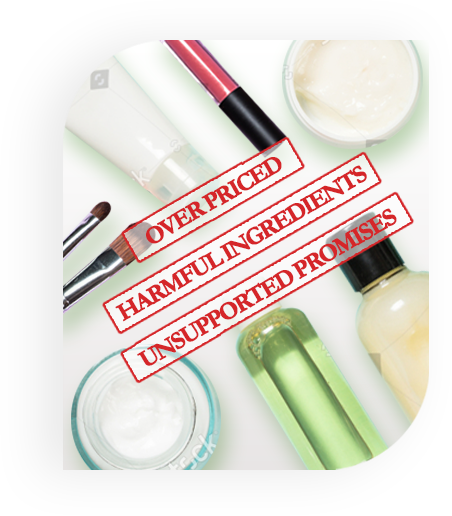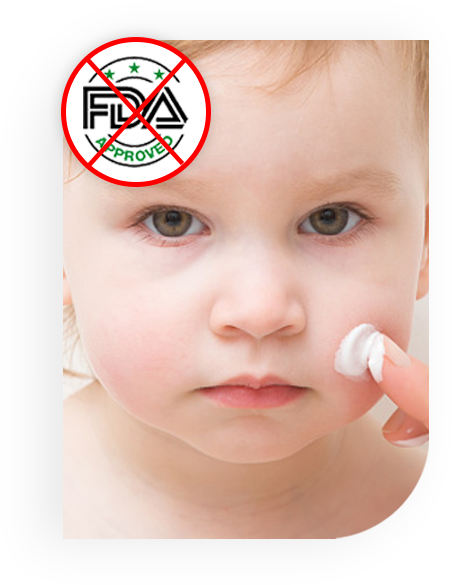Stay Safe – Save Money – Achieve the Best Skin and Hair Ever!
Stay Safe – Save Money – Achieve the Best Skin and Hair Ever!
You may be surprised to know that skincare, cosmetics and hair care products - with their beautiful package designs, elaborate marketing campaigns, and celebrity endorsements - are mostly unregulated by the FDA, and can be more harmful than what you eat.
Europe Bans Over 1,400 Harmful Ingredients
U.S. Bans Only 30
The European Common Market (40 countries), and Canada, Japan, and Australia ban and restrict over 1,440 cosmetics and personal care ingredients. In contrast, the U.S. bans only 30.
Lack of U.S. Regulation
The lack of much needed regulation is due to a politically strong cosmetics industry combined with the fact that the Food and Drug Administration (FDA) is governed by a law, which hasn’t been updated since it was written in 1938. This outdated law gives the FDA little power to regulate ingredients used in the personal care industry, or the high prices brands charge for these products, or the unsupported promises they make in their marketing campaigns.

According to the California Department of Public Health, no category of consumer products is subject to less government oversight than cosmetics and other personal care products.

Over 60% of What You Put on Your Skin is Absorbed and Enters Your Blood Within 26 Seconds.
More Harmful Than What You Eat
What you put on your skin can be more harmful than what you eat, because the food you eat passes through your detoxification organs such as kidney, colon, and liver, where the enzymes in our body help in breaking it down, and neutralizing harmful substances. But the creams, ointments, lotions, and cosmetics we use on our skin goes completely unfiltered directly into our bloodstream.
Even Small Amounts of Toxic Ingredients Can Be Harmful
Even a small amount of toxic ingredients with a single product or combined use of many different toxic products, can be harmful.
This chemical exposure has been linked to rising rates in breast and other cancers, cardiovascular disease, harm to the reproductive system, infertility, low sperm counts, autism, slow child development, Alzheimer’s, organ failure and many immediate skin and hair problems and long term degenerative diseases. A few are listed below:
Toxic Exposure for Children
Toxic ingredient exposures in children are a significant concern because of a number of factors including a higher metabolic rate, immaturity of organ systems, and rapid growth and development of organs and tissues such as bone and brain. Children can be exposed to these harmful ingredients not only through products applied to their skin, but also from residue on their clothes washed with toxic soaps, or household surfaces or toys they touch that have been cleaned with products containing toxic ingredients.
Natural and Organic Products Can Be Harmful
Even brands labeled ‘natural’, ‘nontoxic, ‘earth friendly’, ‘green’, ‘vegan’, ‘plant based’, organic’ or other such terms include harmful ingredients. These words have no regulatory meaning in terms of the FDA, and their use in the U.S. in any personal care or household product labeling or marketing material means almost nothing.

Arsenic for example, is considered a ‘Natural’ ingredient, and can be on the label with one of its dozen not commonly known alternate names including Atomic Number 33, Fowler's Solution, Numero Atomique 33, Solution de Fowler, and many others.
Take A Moment And Think About How Many Personal Care Products You Use Each Day That May Be Harmful:

Ingredients You’re Using May Be Causing the Problems You’re Trying to Solve
The products you're using to address one skin or hair concern might be causing other problems like acne, fine lines,wrinkles, eye puffiness, hair brittleness, dullness and damage, as well as hair loss or other hair concerns.
Ingredients You’re Allergic To May Be Called Dozens of Other Names You Don’t Know
Ingredients you’re allergic to can behidden from you by the use of dozens of its alternate names on the label., which makes it more difficult to avoid those ingredients, or avoid harmful ingredients.
The ingredient nickel for example, may be identified on a product label as any of the following alternate names: Atomic number 28, Chlorure de Nickel, Ni, Nickel Chloride, Nickel Sulfate, Nickelous Sulfate, Níquel, Numéro Atomique 28, Oligo-Élément, Sulfate de Nickel, Sulfate Nickeleux, Trace Element and many others.